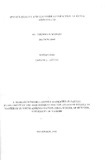| dc.description.abstract | Both descriptive and inferential statistics were used to analyze the study findings for the
63(63%) of the respondents that gave their responses. Descriptive analysis involved use
of measures such as means, standard deviations, and variance. Inferential statistics
included both reliability testing of the study parameters as well as tests conducted to
investigate multivariate relationships between the major study variables. In the reliability
testing, The Bartlett’s test of sphericity and KMO parameters were used. The indicators
used to quantify the major variables yielded a KMO value of 0.558, indicating that
extracted parameters would account for satisfactory variance in the major variable being
measured. It was therefore adequate to conduct factor analysis.
A total of 22 indicators were reduced by factor analysis to 7. All the extracted factors had
Eigen values >1 and combined factor loadings of more than 70%. Tests for
multicollinearity among the indicators were also conducted and they revealed r-square
(r2) values of < 0.49, meaning insignificant interrelationships. Consequently,
multicollinearity was not of concern and the indicators used were satisfactorily
independent.
This study concluded that the major determinants of service quality among airline
passengers were; luggage handling, assurance and responsiveness, which had the top 3
factor loading scores. | en |

